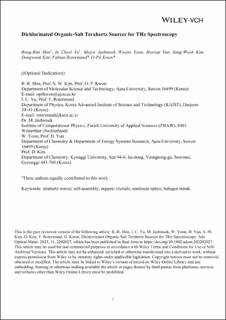Please use this identifier to cite or link to this item:
https://doi.org/10.21256/zhaw-30288| Publication type: | Article in scientific journal |
| Type of review: | Peer review (publication) |
| Title: | Dichlorinated organic‐salt terahertz sources for THz spectroscopy |
| Authors: | Shin, Bong‐Rim Yu, In Cheol Jazbinsek, Mojca Yoon, Woojin Yun, Hoseop Kim, Sang‐Wook Kim, Dongwook Rotermund, Fabian Kwon, O‐Pil |
| et. al: | No |
| DOI: | 10.1002/adom.202202027 10.21256/zhaw-30288 |
| Published in: | Advanced Optical Materials |
| Volume(Issue): | 11 |
| Issue: | 4 |
| Page(s): | 2202027 |
| Issue Date: | Feb-2023 |
| Publisher / Ed. Institution: | Wiley |
| ISSN: | 2195-1071 |
| Language: | English |
| Subjects: | THz Photonics; Halogen bonds; Terahertz waves; Nonlinear optics; Self-assembly; Organic crystals |
| Subject (DDC): | 621.3: Electrical, communications, control engineering |
| Abstract: | Although in terahertz (THz) source materials molecular anions significantly influence the performance of THz generation, only limited classes of molecular counter anions have been reported. Here, utilizing dichlorinated molecular anions in THz generators is reported for the first time, to the best of our knowledge. In these new crystals, two dichlorinated molecular anions with different molecular symmetries, asymmetric 3,4-dichlorobenzenesulfonate (34DCS) and symmetric 3,5-dichlorobenzenesulfonate (35DCS), are incorporated with a 2-(4-hydroxystyryl)-1-methylquinolinium (OHQ) cation possessing top-level molecular optical nonlinearity. OHQ-34DCS exhibits a strong nonlinear optical response, in contrast to OHQ-35DCS. In OHQ-34DCS crystals, the dichlorinated groups form strong halogen bonds (XBs) and hydrogen bonds (HBs), which are beneficial for suppressing molecular (phonon) vibrations. The optical-to-THz conversion efficiency of the OHQ-34DCS crystals is extremely high, comparable to that of the benchmark organic THz generators. Moreover, the THz emission spectra from the OHQ-34DCS crystals, compared to those of previously reported benchmark analogous crystals, are stronger modulated toward a flatter shape, but possess substantially reduced spectral dimples. Therefore, the introduction of dichlorinated molecular anions is an efficient approach for the design of highly efficient electro-optic salt crystals as efficient broadband THz wave sources. |
| URI: | https://digitalcollection.zhaw.ch/handle/11475/30288 |
| Fulltext version: | Accepted version |
| License (according to publishing contract): | Licence according to publishing contract |
| Departement: | School of Engineering |
| Organisational Unit: | Institute of Computational Physics (ICP) |
| Appears in collections: | Publikationen School of Engineering |
Files in This Item:
| File | Description | Size | Format | |
|---|---|---|---|---|
| 2023_Shin-etal_Dichlorinated-organic-salt-terahertz.sources-spectroscopy_adom_AAM.pdf | Accepted Version | 1.35 MB | Adobe PDF |  View/Open |
Show full item record
Shin, B.-R., Yu, I. C., Jazbinsek, M., Yoon, W., Yun, H., Kim, S.-W., Kim, D., Rotermund, F., & Kwon, O.-P. (2023). Dichlorinated organic‐salt terahertz sources for THz spectroscopy. Advanced Optical Materials, 11(4), 2202027. https://doi.org/10.1002/adom.202202027
Shin, B.-R. et al. (2023) ‘Dichlorinated organic‐salt terahertz sources for THz spectroscopy’, Advanced Optical Materials, 11(4), p. 2202027. Available at: https://doi.org/10.1002/adom.202202027.
B.-R. Shin et al., “Dichlorinated organic‐salt terahertz sources for THz spectroscopy,” Advanced Optical Materials, vol. 11, no. 4, p. 2202027, Feb. 2023, doi: 10.1002/adom.202202027.
SHIN, Bong‐Rim, In Cheol YU, Mojca JAZBINSEK, Woojin YOON, Hoseop YUN, Sang‐Wook KIM, Dongwook KIM, Fabian ROTERMUND und O‐Pil KWON, 2023. Dichlorinated organic‐salt terahertz sources for THz spectroscopy. Advanced Optical Materials. Februar 2023. Bd. 11, Nr. 4, S. 2202027. DOI 10.1002/adom.202202027
Shin, Bong‐Rim, In Cheol Yu, Mojca Jazbinsek, Woojin Yoon, Hoseop Yun, Sang‐Wook Kim, Dongwook Kim, Fabian Rotermund, and O‐Pil Kwon. 2023. “Dichlorinated Organic‐Salt Terahertz Sources for THz Spectroscopy.” Advanced Optical Materials 11 (4): 2202027. https://doi.org/10.1002/adom.202202027.
Shin, Bong-Rim, et al. “Dichlorinated Organic‐Salt Terahertz Sources for THz Spectroscopy.” Advanced Optical Materials, vol. 11, no. 4, Feb. 2023, p. 2202027, https://doi.org/10.1002/adom.202202027.
Items in DSpace are protected by copyright, with all rights reserved, unless otherwise indicated.